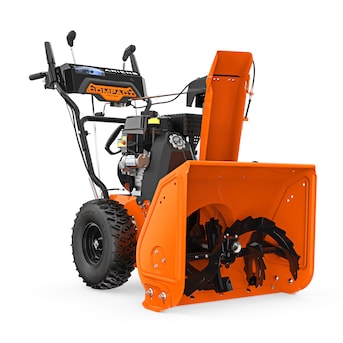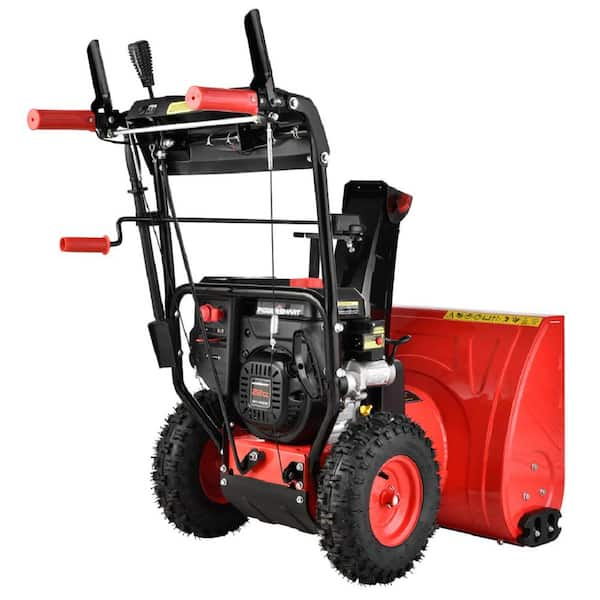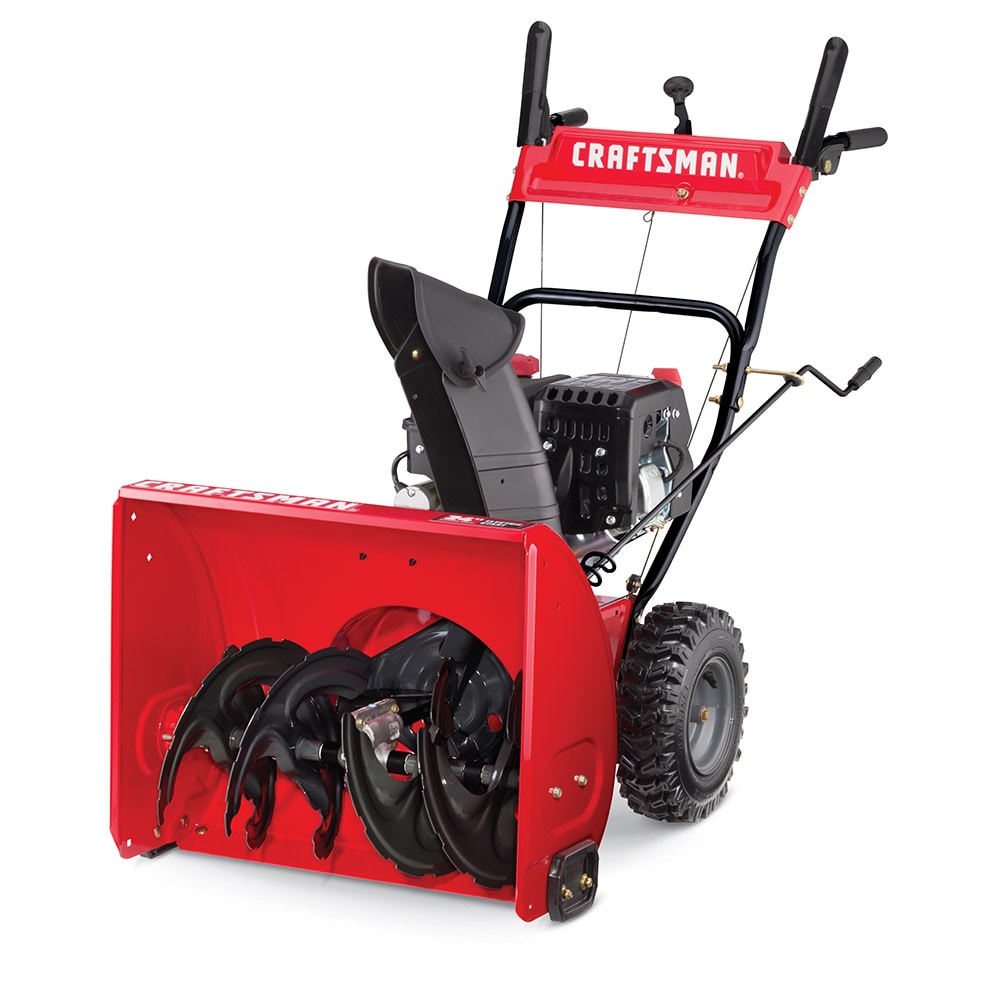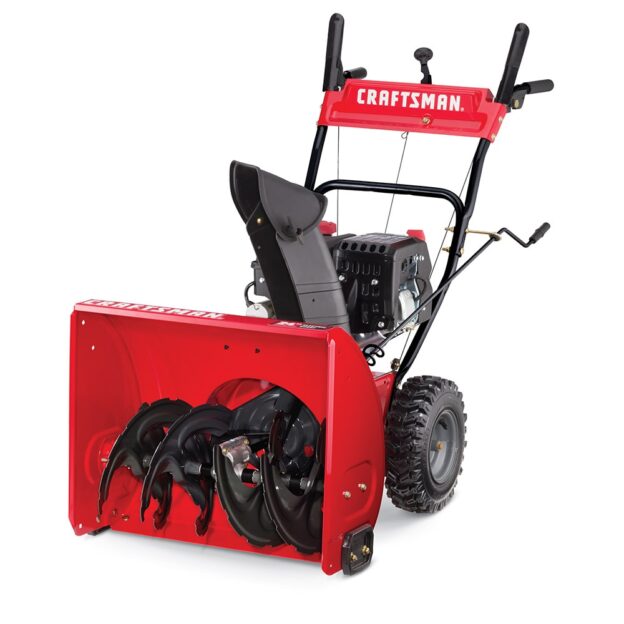In the midst of winter, when snow blankets the ground and makes it nearly impossible to navigate, having a reliable snow blower is a godsend. But with countless options available, it can be overwhelming to determine the right size for your needs. One commonly asked question is, “Is a 24-inch snow blower big enough?” While size certainly matters, there are multiple factors to consider when choosing the right snow blower for your snow-clearing needs. Let’s explore the advantages and disadvantages of a 24-inch snow blower to help you make an informed decision.

This image is property of www.snowblowers.net.
Factors to Consider
When it comes to choosing the right snow blower for your needs, there are several factors that you need to take into consideration. By carefully considering these factors, you can ensure that you select a snow blower that is perfectly suited to your specific requirements.
Average Snowfall in Your Area
Understanding the average snowfall in your area is crucial in determining the size and capacity of the snow blower you should choose. Different regions experience varying levels of snowfall, and it’s important to consider whether the average snowfall in your area is light or heavy.
Size of Your Driveway or Walkway
The size of your driveway or walkway plays a significant role in determining the size and power of the snow blower you require. If you have a smaller driveway or walkway, a compact snow blower may be sufficient. However, if you have a larger area to clear, a larger and more powerful snow blower may be necessary to get the job done efficiently.
Type of Snow
Snow comes in different textures and compositions. It can be light and dry, wet and heavy, or even icy and packed. It’s crucial to consider the type of snow you typically encounter in your area, as different snow conditions require different types of snow blowers. Some snow blowers may struggle with wet and heavy snow, while others are specifically designed to tackle icy conditions.
Frequency of Use
Another important factor to consider is how frequently you will be using your snow blower. Are you only going to use it occasionally, during particularly heavy snowstorms? Or will you be using it on a regular basis throughout the winter season? The frequency of use will determine the durability and capacity of the snow blower you should choose.
Time and Effort Required
Clearing snow can be a time-consuming and physically demanding task. It’s essential to consider how much time and effort you are willing to put into clearing your driveway or walkway. Some snow blowers are designed to be more efficient and require less physical effort, while others may require more time and physical exertion.
Average Snowfall in Your Area
Understanding Snowfall Measurements
Before diving into the specifics of snow blowers, it’s important to have a basic understanding of snowfall measurements. Snowfall is typically measured in inches, and this measurement indicates the depth of snow that has fallen in a particular area.
Typical Snowfall Ranges
Snowfall ranges can vary significantly depending on your geographical location. In some regions, the average snowfall may be minimal, ranging from a few inches to a foot. In other areas, heavy snowfall of several feet is more common. By knowing the typical snowfall ranges in your area, you can gauge the size and capacity of snow blower that will be suitable.
Evaluating Snow Blower Capacity
Snow blower capacity refers to the amount of snow a particular machine can handle. It is typically measured in pounds per minute or tons per hour. Evaluating the snow blower capacity will help you determine its efficiency and suitability for the average snowfall in your area. a 24 inch snow blower may be sufficient for light to moderate snowfall, but larger capacity snow blowers may be required for heavy snowfall.
Size of Your Driveway or Walkway
Measuring the Area
To determine the size and power of the snow blower you need, you will first need to measure the area you intend to clear. Measure the width and length of your driveway or walkway to calculate the total square footage. This measurement will help you determine the size and capacity of the snow blower that will be most effective for your needs.
Suitability for 24 Inch Snow Blower
A 24 inch snow blower is generally suitable for smaller driveways and walkways. If your driveway or walkway is relatively narrow and doesn’t require extensive clearing, a 24 inch snow blower can be a great choice. However, if you have a larger area to clear, a wider clearing width may be more efficient.
Considering Alternative Options
If a 24 inch snow blower is not suitable for the size of your driveway or walkway, there are alternative options to consider. Larger snow blowers with wider clearing widths are available to tackle larger areas. Additionally, you may also want to explore the option of hiring professional snow removal services or investing in a snow plow attachment for your vehicle.
Type of Snow
Light and Dry Snow
Light and dry snow is typically easier to clear than wet and heavy snow. A 24 inch snow blower is generally capable of handling light and dry snow with ease. The lightweight nature of this type of snow allows the snow blower to effectively throw the snow to the side, clearing your driveway or walkway efficiently.
Wet and Heavy Snow
On the other hand, wet and heavy snow can be much more challenging to clear. This type of snow has a higher water content, making it heavier and more difficult to lift and throw with a snow blower. While a 24 inch snow blower may still be able to handle wet and heavy snow to some extent, it may require multiple passes or additional physical effort on your part.
Ice and Packed Snow
Ice and packed snow can present another set of challenges when it comes to snow removal. This type of snow can be hard and compacted, requiring more power and specialized features to effectively break it up and remove it. While a 24 inch snow blower may have some capability in handling ice and packed snow, there are models specifically designed for these conditions that may be more suitable.
Ability to Handle Different Types
When choosing a snow blower, it’s important to consider its ability to handle different types of snow. While a 24 inch snow blower may be ideal for lighter snow conditions, it may struggle with wet and heavy snow or ice and packed snow. Understanding the limitations of a 24 inch snow blower will help you make an informed decision based on the type of snow you typically encounter.

This image is property of mobileimages.lowes.com.
Frequency of Use
Occasional Use
If you only anticipate using a snow blower occasionally, such as during particularly heavy snowstorms, a 24 inch snow blower can be a practical choice. Its compact size and maneuverability make it easy to store and use as needed, without taking up excessive space in your garage or shed.
Regular Use
For those who plan on using a snow blower on a regular basis throughout the winter season, a 24 inch snow blower may still be suitable. Regular use will require a reliable and durable snow blower that can handle the task at hand. However, it’s important to ensure that the snow blower you choose can hold up to frequent use and heavy snowfall.
Heavy-Duty Use
If you live in an area that experiences frequent and heavy snowfall, or if you have a large area to clear, a 24 inch snow blower may not be sufficient for heavy-duty use. In these cases, it may be worth considering larger and more powerful snow blowers that are specifically designed for heavy-duty use and can handle larger snow clearing tasks.
Matching Snow Blower Capacity
Matching the capacity of your snow blower to your anticipated frequency of use is crucial. A 24 inch snow blower may be sufficient for occasional or regular use, but heavy-duty use may require a larger capacity machine. Consider how often and how much snow you will be clearing to ensure that the snow blower you choose can handle the workload.
Time and Effort Required
Clearing Time Considerations
The time required to clear your driveway or walkway can vary depending on the size of the area, the amount of snowfall, and the capacity of your snow blower. A 24 inch snow blower can generally clear a driveway or walkway efficiently, but it may take longer to clear larger areas. Consider the amount of time you are willing to spend clearing snow to determine if a 24 inch snow blower is suitable for your needs.
Physical Effort Involved
Clearing snow can be physically demanding, especially if you have a larger area to clear or if the snow is wet and heavy. While a 24 inch snow blower can make the task easier, it still requires some physical effort on your part. If you have any physical limitations or prefer a less physically demanding option, you may want to explore alternative snow removal methods or consider a snow blower with additional features for enhanced efficiency.
Balancing Efficiency and Comfort
Balancing efficiency and comfort is essential when selecting a snow blower. While a larger and more powerful snow blower may provide faster and more efficient snow clearing, it may also require more physical effort. A 24 inch snow blower offers a good balance between efficiency and comfort for most residential users, but it’s important to assess your personal preferences and capabilities when making your decision.

This image is property of images.thdstatic.com.
Additional Features to Enhance Performance
Engine Power and Torque
The engine power and torque of a snow blower play a crucial role in determining its performance. A higher power and torque rating generally indicate a more powerful and capable snow blower. Consider the typical snow conditions in your area and the size of the area you need to clear when evaluating the engine power and torque of a snow blower.
Clearing Width and Intake Height
The clearing width and intake height of a snow blower determine the amount of snow it can clear in a single pass. A wider clearing width and higher intake height can significantly reduce the time it takes to clear your driveway or walkway. While a 24 inch snow blower may be sufficient for smaller areas, a wider clearing width and higher intake height may be desired for larger areas.
Auger and Impeller Design
The auger and impeller design of a snow blower affect its ability to propel snow and throw it to the side. A well-designed auger and impeller system can enhance the performance and efficiency of a snow blower, allowing it to handle different types of snow with ease. When considering a 24 inch snow blower, evaluate the auger and impeller design to ensure its capability.
Tire Traction and Steering
Snow blowers with good tire traction and steering capabilities offer better maneuverability and control. This is particularly important when navigating through uneven or slippery surfaces. A 24 inch snow blower with reliable tire traction and easy steering can make the snow clearing process smoother and more efficient.
Advanced Features for Efficiency
Some snow blowers come with advanced features that enhance their efficiency and user experience. These features may include electric start, heated handles, remote chute control, and more. While these features are not essential, they can significantly improve the overall performance and convenience of your snow blower.
Benefits of a 24 Inch Snow Blower
Compact Size and Maneuverability
One of the key benefits of a 24 inch snow blower is its compact size and maneuverability. Its smaller dimensions make it easier to store and transport, and it can navigate tight spaces with ease. If you have a smaller driveway or walkway, a 24 inch snow blower can provide efficient snow clearing without being bulky or difficult to handle.
Suitable for Residential Use
A 24 inch snow blower is typically designed for residential use. It is ideal for homeowners who need to clear their driveways or walkways during the winter season. These snow blowers are often more cost-effective compared to larger models and provide sufficient power and efficiency for residential snow clearing needs.
Efficiency in Moderate Snowfall
For areas that experience moderate snowfall, a 24 inch snow blower can be an efficient choice. It can handle light to moderate snow conditions with ease, quickly clearing your driveway or walkway. With its smaller size, it can effectively maneuver through smaller snow piles and tight spaces.
Ease of Storage
The compact size of a 24 inch snow blower makes it easy to store when not in use. It takes up minimal space in your garage or shed, allowing you to store other items alongside it. If you have limited storage space or simply prefer a snow blower that doesn’t take up too much room, a 24 inch snow blower is a practical choice.

This image is property of images.thdstatic.com.
Limitations of a 24 Inch Snow Blower
Inadequate for Heavy Snowfall
One of the limitations of a 24 inch snow blower is its capacity to handle heavy snowfall. In areas that experience significant snow accumulation, a 24 inch snow blower may struggle to clear larger amounts of snow efficiently. It may require multiple passes or become overwhelmed by heavy snow, potentially leading to clogging or reduced performance.
Challenging with Wet and Heavy Snow
Wet and heavy snow can pose a challenge for a 24 inch snow blower. The added weight of the snow can strain the snow blower’s capacity and reduce its efficiency. While a 24 inch snow blower may still be able to handle wet and heavy snow to some extent, it may require additional physical effort on your part and may not clear the snow as effectively.
Time-Consuming for Large Areas
If you have a larger area to clear, a 24 inch snow blower may prove to be time-consuming. Its smaller clearing width means that it will take more passes to clear a larger space. If you have a long driveway or a large walkway, you may want to consider a wider clearing width or alternative options, such as larger snow blowers or professional snow removal services.
Alternatives to a 24 Inch Snow Blower
Larger Snow Blowers
For those who require more power and capacity, larger snow blowers are available. These snow blowers often have wider clearing widths, higher intake heights, and more powerful engines. If you have a large area to clear or frequently encounter heavy snowfall, a larger snow blower may be a better choice than a 24 inch snow blower.
Snow Plows
Snow plows are another alternative to consider for snow removal. They can be attached to vehicles such as trucks or SUVs, making them particularly convenient for clearing larger driveways or parking lots. Snow plows are designed to efficiently push snow to the side, allowing for quick and thorough clearing.
Professional Snow Removal Services
If snow removal is a task that you’d rather leave to the professionals, hiring a snow removal service may be the best option. Professional snow removal services have the equipment and expertise to handle any snow clearing needs. They can efficiently clear your driveway, walkway, and other areas, saving you time and effort.
In conclusion, choosing the right snow blower involves considering various factors such as the average snowfall in your area, the size of your driveway or walkway, the type of snow you typically encounter, the frequency of use, and the time and effort required. While a 24 inch snow blower can be a suitable choice for many homeowners, it is important to assess its limitations and consider alternative options if necessary. By carefully evaluating your specific needs and the features of different snow blowers, you can select the ideal machine to keep your driveway or walkway clear and safe during the winter season.

This image is property of mobileimages.lowes.com.
